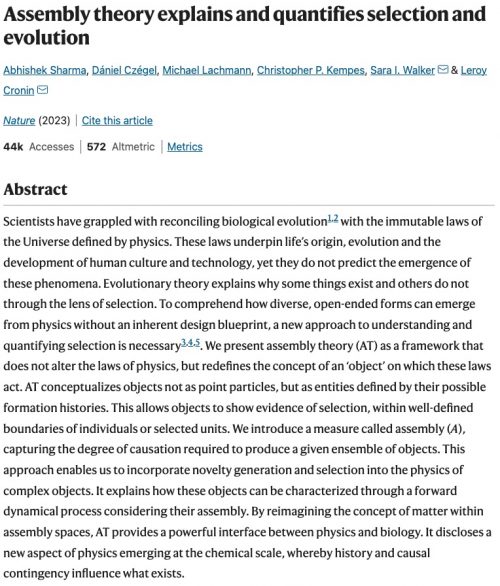How exactly did this dreck, Assembly theory explains and quantifies selection and evolution, get published in Nature?
It’s a stunningly bad paper to be published in such a prestigious journal. Let’s dissect that abstract, shall we?
Scientists have grappled with reconciling biological evolution1,2 with the immutable laws of the Universe defined by physics.
This makes no sense. Evolutionary biologists have not had any problem with physical laws — it has always been assumed, as far as I know, that biology fits within the framework of chemistry and physics. What grappling? Have biologists been proposing theories that violate physics, and they didn’t tell me?
The citations to back up that outré claim are Stuart Kauffman, who can get a little weird but not that weird, and Ryan Gregory, whose papers I’ve used in class, and is probably a bit annoyed at being told his work supports that ridiculous claim.
These laws underpin life’s origin, evolution and the development of human culture and technology, yet they do not predict the emergence of these phenomena.
Sure. Emergent properties exist. We know you can’t simply derive all of biology from Ideal Gas Law. So far, nothing new.
Evolutionary theory explains why some things exist and others do not through the lens of selection.
Uh-oh. Just selection? Tell me you know nothing of evolutionary biology without saying you don’t know anything about evolutionary biology.
To comprehend how diverse, open-ended forms can emerge from physics without an inherent design blueprint, a new approach to understanding and quantifying selection is necessary3,4,5.
Here it comes, more bad theorizing. It is implicit in evolution that there is no “inherent design blueprint,” so where did these authors get the idea that design was a reasonable alternative? They don’t say. This is simply another imaginary controversy they’ve invented to make their theory look more powerful.
We don’t need a new approach
to selection. To support that, they cite Charles Darwin (???) and Sean B. Carroll, and a fellow named Steven Frank, whose work I’m unfamiliar with. A quick search shows that he applies “evolutionary principles to the biochemistry of microbial metabolism,” which doesn’t sound foreign to standard biology, although he does throw the word “design” around a lot.
But here we go:
We present assembly theory (AT) as a framework that does not alter the laws of physics, but redefines the concept of an ‘object’ on which these laws act. AT conceptualizes objects not as point particles, but as entities defined by their possible formation histories. This allows objects to show evidence of selection, within well-defined boundaries of individuals or selected units.
Again, what biological theory has ever been proposed that alters the laws of physics? They keep touting this as a key feature of their model, that it doesn’t break physics, but no credible theory does. This talk of formation histories
is nothing revolutionary, history and contingency are already important concepts in biology. Are they really going to somehow quantify “assembly”? They’re going to try.
We introduce a measure called assembly (A), capturing the degree of causation required to produce a given ensemble of objects. This approach enables us to incorporate novelty generation and selection into the physics of complex objects. It explains how these objects can be characterized through a forward dynamical process considering their assembly.
I’ve heard this all before, somewhere. A new term invented, a claim of a novel measure of the complexity of a pathway, a shiny new parameter with no clue how to actually measure it? This is just ontogenetic depth! Paul Nelson should be proud that his bad idea has now been enshrined in the pages of Nature, under a new label. I did a quick check: Nelson is not cited in the paper. Sorry, Paul.
Here is all assembly theory
is: You count the number of steps it takes to build an organic something, and presto, you’ve got a number A
that tells you how difficult it was to evolve that something. That’s it. Biology is revolutionized and reconciled with physics. It’s just that stupid.

a–c, AT is generalizable to different classes of objects, illustrated here for three different general types. a, Assembly pathway to construct diethyl phthalate molecule considering molecular bonds as the building blocks. The figure shows the pathway starting with the irreducible constructs to create the molecule with assembly index 8. b, Assembly pathway of a peptide chain by considering building blocks as strings. Left, four amino acids as building blocks. Middle, the actual object and its representation as a string. Right, assembly pathway to construct the string. c, Generalized assembly pathway of an object comprising discrete components.
I told you, it’s just ontogenetic depth, with basic math. Here’s how to calculate A
:
All you have to do is recursively sum the value of A
for each object in the series, and you get the value of A
for the whole! How you calculate the value of A
for, say, acetate or guanine or oxaloacetic acid or your nose or a lobe of your liver is left as an exercise for the reader. It is also left as an exercise for the reader to figure out how A
is going to affect their implementation of evolutionary biology.
By reimagining the concept of matter within assembly spaces, AT provides a powerful interface between physics and biology. It discloses a new aspect of physics emerging at the chemical scale, whereby history and causal contingency influence what exists.
I read the whole thing. I failed to see any new aspect of physics
, or any utility to the theory at all. I don’t see any way to apply this framework
to evolutionary biology, or what I’d do if I could calculate A
for one of my spiders (fortunately, I don’t see any way to figure out the A
of Steatoda triangulosa, so I’m spared the effort of even trying.)
The primary author, Leroy Cronin, a chemistry professor at the University of Glasgow, acknowledges that the work was funded by the John Templeton Foundation. Quelle surprise!
I honestly don’t understand how such a steaming pile managed to get past the editors and reviewers at Nature. It should have been laughed away as pure crank science and tossed out the window. There has to have been a lot of steps where peer review failed…maybe someone should try to calculate the assembly value
for getting a paper published in Nature so we can figure out how it happened.
Sharma, A., Czégel, D., Lachmann, M. et al. Assembly theory explains and quantifies selection and evolution. Nature (2023). https://doi.org/10.1038/s41586-023-06600-9

















